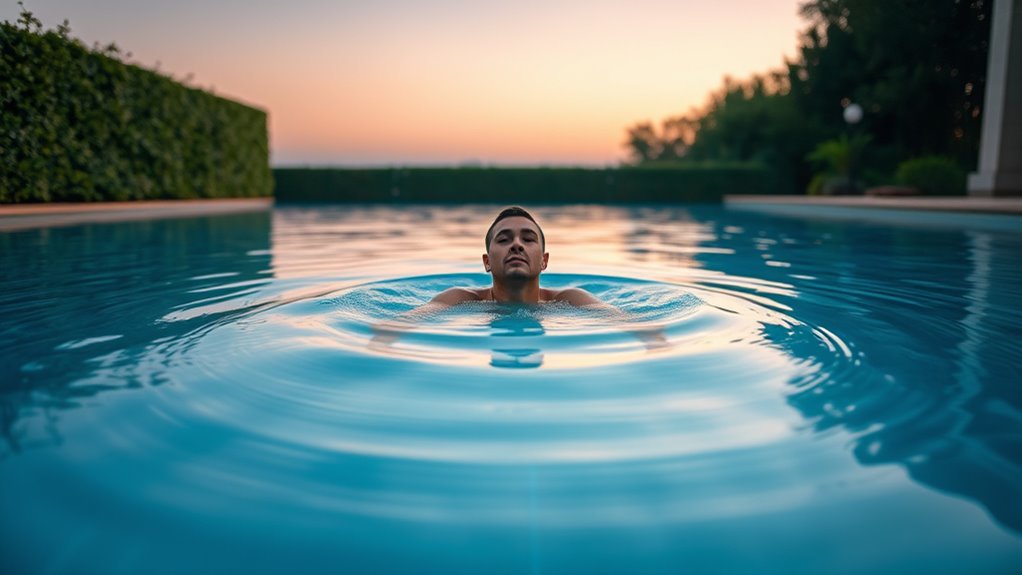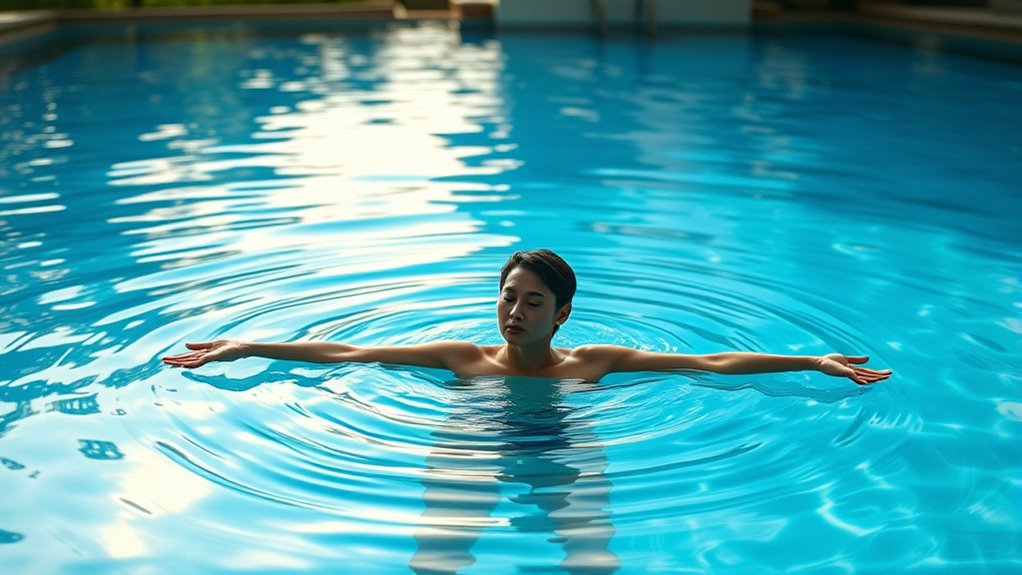To turn your pool time into meditation, focus on mindful breathing and sensory awareness. Take slow, deep breaths and pay attention to how the water feels and moves around you. Move deliberately, noticing each stroke, kick, and sensation without rushing. When your mind wanders, gently bring it back to your breath and body. Practicing this regularly can deepen your relaxation and clarity—continue exploring how to transform your swim into a peaceful meditation.
Key Takeaways
- Focus on slow, deliberate breathing to anchor awareness and enhance relaxation during each swim.
- Pay close attention to water sensations, such as temperature, texture, and flow, to stay present.
- Move mindfully through strokes, integrating awareness of muscles, water resistance, and movement rhythm.
- Gently redirect your attention whenever your mind drifts, maintaining steady focus on the current moment.
- View swimming as a mental sanctuary, using it to foster clarity, emotional balance, and holistic well-being.

Have you ever considered how swimming can become more than just exercise? When you immerse yourself in the pool with mindful intent, your swim transforms into a meditative practice that nurtures both body and mind. The key lies in focusing on your breathing techniques and sharpening your sensory awareness. Instead of rushing through laps or zoning out, you become fully present in each movement, each breath, and each sensation the water provides. Practicing mindfulness tools can help deepen this experience and reinforce your focus during each swim. Start by paying close attention to your breathing. As you glide through the water, take slow, deliberate breaths. Inhale deeply through your nose, feeling the coolness of the air, and exhale steadily through your mouth or nose, releasing tension with each breath. This rhythmic breathing anchors you in the moment and helps calm your nervous system. By consciously controlling your breath, you not only improve your lung capacity but also create a steady rhythm that guides your entire swim. This focus on breathing techniques turns swimming into a form of moving meditation, where each breath becomes a reminder to stay present. Sensory awareness is equally essential. Feel the water against your skin, notice the temperature and texture. Observe how it flows around your body with each stroke, each kick, and each turn. Pay attention to the sensation of your muscles working, the sound of your breath, and the rhythm of your strokes. Let your senses guide you rather than letting your mind wander. Notice the way your body moves through the water, the resistance you encounter, and the pressure of the water supporting you. This heightened sensory awareness grounds you in the experience, making your swim a deeply mindful activity rather than just physical exertion. As you develop these mindfulness practices, your swimming sessions will become more intentional and restorative. Instead of viewing the pool as a place to burn calories or improve fitness alone, see it as a sanctuary for mental clarity and emotional balance. Each lap becomes a moment to connect with your body and the present moment. When your mind drifts, gently bring it back to your breath and the sensations in your body. Over time, this deliberate focus can help reduce stress, improve concentration, and foster a sense of calm that extends beyond the pool. Incorporating mindful breathing techniques and sensory awareness into your swimming routine isn’t complicated. It just requires your willingness to slow down, observe, and stay present. With consistent practice, you’ll find that your pool time becomes a powerful form of meditation—an oasis where physical activity and mental peace seamlessly merge into one fulfilling experience.
Frequently Asked Questions
Can Beginners Easily Practice Mindful Swimming?
As a beginner, you can definitely practice mindful swimming, but it may take some patience. Focus on maintaining a comfortable water temperature and choose simple swimming strokes like freestyle or backstroke. Concentrate on your breath, sensations, and movement. Start slow, stay relaxed, and gradually build your awareness. With consistent practice, you’ll find it easier to stay present and enjoy the calming benefits of mindful swimming.
What Equipment Is Necessary for Mindful Swimming?
To practice mindful swimming, you don’t need much equipment—just basic swimming accessories like goggles and a swim cap for comfort. Focus on your breathing and movements while ensuring pool safety by staying aware of your surroundings. Minimal gear helps you stay present and relaxed, making it easier to meditate in the water. Keep safety in mind, and let your awareness flow naturally with each stroke.
How Long Should a Mindful Swimming Session Last?
You should aim for a mindful swimming session lasting about 20 to 30 minutes, depending on your comfort and focus. Keep the pool temperature at a soothing level, around 78-82°F, to enhance relaxation. Use gentle swimming strokes, like backstroke or freestyle, to stay present. Shorter sessions can be effective if you’re new, while longer ones deepen your meditation. Listen to your body and enjoy the calming experience.
Are There Specific Breathing Techniques for Mindful Swimming?
You can enhance your mindful swimming by focusing on specific breathing techniques, like breath awareness and diaphragmatic breathing. As you swim, pay close attention to your breath, feeling each inhale and exhale. Use diaphragmatic breathing to deepen each breath, helping you stay present and calm. This intentional focus on your breath transforms your pool time into a meditative experience, promoting relaxation and mindfulness with every stroke.
Can Mindful Swimming Help Manage Stress or Anxiety?
You might think stress is a tough nut to crack, but aquatic mindfulness through mindful swimming offers real benefits. This form of meditation can reduce anxiety, enhance relaxation, and improve overall well-being. By focusing on your breath and movement, you open up meditation benefits that help manage stress effectively. Immersing yourself in the pool helps you stay present, turning your swim into a calming, meditative experience.
Conclusion
As you glide through the water, let your thoughts drift like clouds on a breeze, each stroke grounding you in the present moment. Embrace the pool as your sanctuary, where every splash becomes a whisper of mindfulness. With each breath and movement, you weave serenity into your day, transforming your swim into a gentle dance of awareness. Dive deeper into this peaceful rhythm, and watch your mind and body harmonize like waves in perfect unison.










